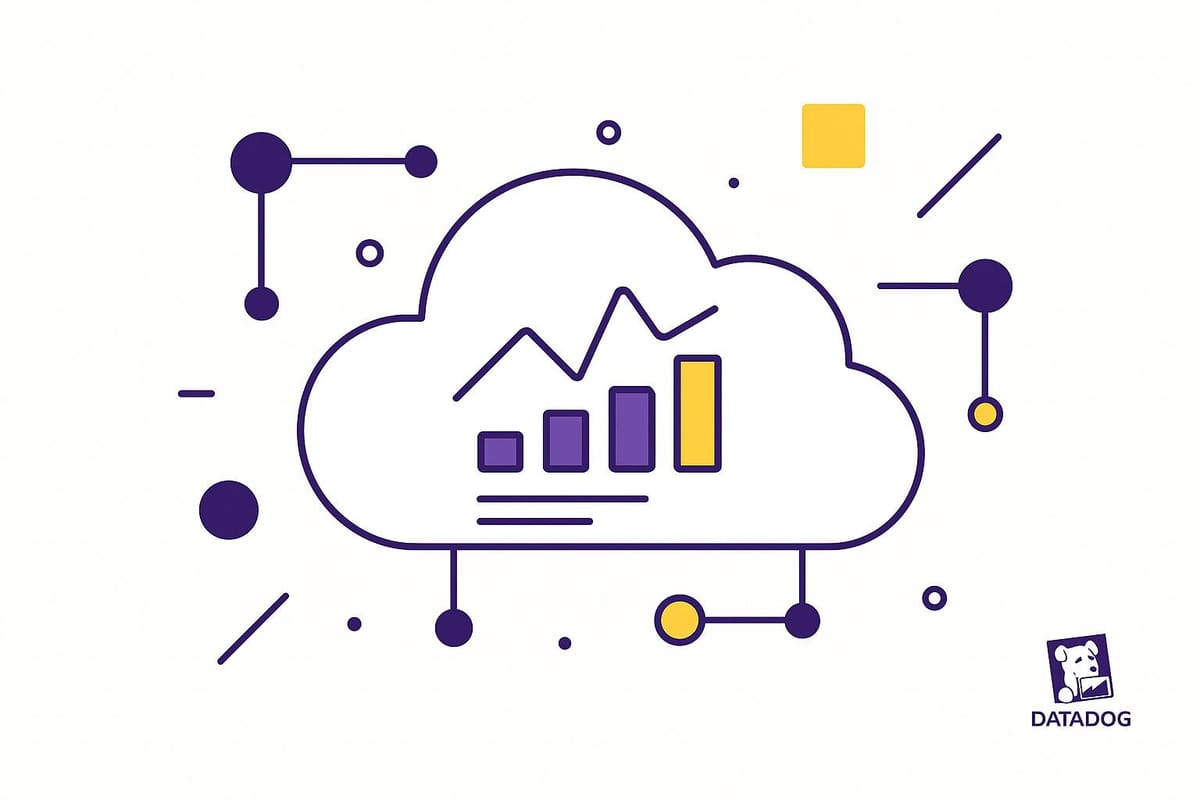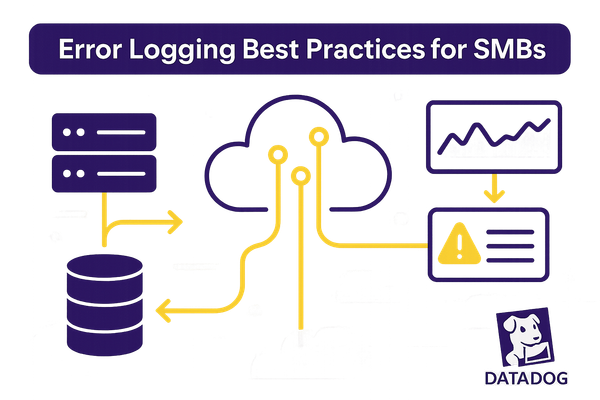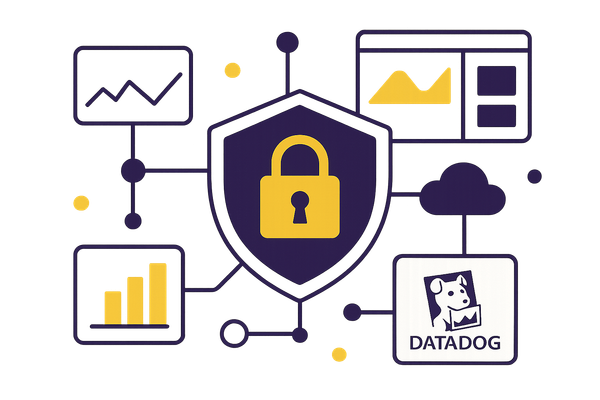Optimize Cloud Costs with Datadog Resource Analysis
Learn how SMBs can optimize cloud costs with Datadog's tools for improved visibility, tracking, and resource management.

Cloud costs can quickly spiral out of control, especially for small and medium-sized businesses (SMBs). Many struggle with unpredictable bills, over-provisioned resources, and limited cost tracking. In fact, 39% of SMBs spent up to $600,000 annually on cloud services as of late 2023, and 24% of that spending is often wasted. Add to that the complexity of cloud pricing and the lack of dedicated IT resources, and it's clear why managing cloud expenses is a challenge.
Datadog simplifies cloud cost management by offering tools that provide clear visibility, real-time monitoring, and actionable insights. With features like unified dashboards, custom tagging, and automated alerts, SMBs can take control of their cloud budgets. For example, companies like Complyt have cut AWS costs by 40% in just an hour using Datadog's tools.
Key Takeaways:
- Unpredictable Costs: Seasonal spikes and hidden fees make cloud bills hard to forecast.
- Wasted Spending: Up to 40% of cloud resources are often over-provisioned or unused.
- Limited Tracking: Untagged resources and decentralized spending lead to inefficiencies.
How Datadog Helps:

- Centralized Dashboards: View all cloud expenses in one place for better tracking.
- Custom Tagging: Allocate costs by team, product, or service for precise insights.
- Real-Time Alerts: Catch spending spikes before they become major issues.
- Right-Sizing Resources: Identify and reduce over-provisioned or idle resources.
By integrating Datadog's tools, SMBs can reduce waste, improve cost tracking, and avoid surprise bills - all while maintaining operational efficiency.
How Complyt used Datadog’s Cloud Cost Management to reduce their cloud spend

Common Cloud Cost Problems for SMBs
Small and medium-sized businesses (SMBs) face a unique set of challenges when it comes to managing cloud expenses. What starts as an investment in technology can quickly spiral into financial headaches if costs aren’t carefully monitored. One of the biggest hurdles? A lack of visibility into spending, which often leads to overspending and makes it even harder to get costs under control.
Unpredictable Cloud Spending
One of the toughest issues for SMBs is the unpredictable nature of cloud bills. Unlike traditional IT expenses, which tend to stay consistent, cloud costs can swing wildly due to usage spikes, seasonal trends, or unexpected surges in demand. For instance, an e-commerce business might see its cloud bill double during Black Friday, only to drop back down afterward - leaving finance teams scrambling to adjust.
Adding to the confusion are hidden fees and complicated pricing structures. Cloud providers often charge separately for things like data transfers, storage operations, and API calls, making it nearly impossible to predict expenses accurately. This unpredictability forces SMBs to react to surprise charges rather than plan ahead effectively.
Over-Provisioning of Resources
Another common issue is over-provisioning, where businesses allocate more resources - like computing power, memory, or storage - than they actually need. While this might feel like a safe bet to prevent performance issues, it often results in paying for capacity that goes unused.
For example, IT teams may select larger instances or extra storage during setup as a precaution, but later audits often reveal that 25–35% of cloud spending is wasted on over-provisioned resources - and in some cases, this figure can exceed 40%. For an SMB with an annual cloud budget of $200,000, that could mean as much as $80,000 wasted on unnecessary resources.
Limited Cost Attribution
Tracking cloud costs at a detailed level is another major pain point. Studies show that 84% of organizations struggle with effective cost management, and untagged resources can account for up to 30% of cloud spending. Cloud bills often provide a high-level total but lack the breakdown needed to pinpoint which teams, projects, or applications are driving the charges.
This problem is worsened by decentralized provisioning, where different departments or employees independently purchase cloud services. Known as shadow IT, these untracked expenses usually only come to light during expense reviews, adding more chaos to the budgeting process.
The impact of poor cost visibility is significant. Around 66% of engineers and 56% of finance professionals report disruptions in their work due to unclear cloud costs, and 89% say that limited visibility directly affects their ability to perform critical tasks. Without detailed tracking, SMBs miss opportunities to optimize their spending and risk facing unpredictable cost increases, making financial planning even more challenging. These issues highlight the growing need for better monitoring tools to help SMBs regain control over their cloud budgets.
How Datadog's Resource Analysis Fixes These Problems
Datadog's Cloud Cost Management platform simplifies cost visibility and control for SMBs. Instead of juggling data from multiple sources, it offers a centralized solution, making it easier for teams to understand and manage cloud expenses.
Unified Dashboards for Cloud Spending
Datadog tackles issues like fragmented data and unpredictable costs by consolidating all cloud expense information into a single dashboard. This means SMBs no longer need to switch between AWS, Azure, or Google Cloud consoles. Everything is accessible in one place.
The dashboards provide a clear view of spending trends and allow filtering by tags such as team, service, or account. Finance teams can quickly detect unusual spending, while engineering teams can see how their services influence overall costs.
What’s more, Datadog integrates cost data into existing tools like the Software Catalog, Resource Catalog, and Container Monitoring. This seamless integration ensures that cost management becomes part of daily workflows, rather than an isolated task handled once a month.
For instance, Complyt managed to cut its AWS expenses by 40% using Datadog's dashboards. Alexander Tilkin, the company's cofounder and CTO, shared:
"In an hour, we cut our total AWS costs by 40 percent. When you have a tool that's very fast, integrates with your cloud provider, and lets you understand where you spend your money, it's very easy to dig deep into utilization of your compute resources."
This remarkable cost reduction is possible because Datadog combines cost and performance data in real time, helping teams identify and address over-provisioned resources or unused capacity immediately.
Custom Tagging for Precise Cost Tracking
Datadog's tagging system addresses the challenge of cost attribution, allowing SMBs to allocate expenses - whether for cloud, container, or SaaS resources - to specific teams, products, or services. Even with shared infrastructure, businesses can track costs with precision.
The flexibility of custom tags lets companies define their own tracking criteria. For example:
- A software company might tag resources by development team, product feature, or customer environment.
- An e-commerce business could tag by sales channel, region, or seasonal campaigns.
These tags enable businesses to analyze costs in ways that are most relevant to their operations. Features like Tag Pipelines and Custom Allocation Rules ensure accurate attribution, even for shared resources.
Martin Amps from Stitch Fix highlighted the benefits:
"Best practices are important, but there's no substitution for real measurement and cost optimization. Datadog Cloud Cost Management helped us attribute spend at a granular level over dozens of accounts to achieve significant savings."
With this level of detail, SMBs can answer questions like "How much does our mobile app cost to run?" or "Which marketing campaign led to the highest infrastructure costs?" This transforms cost management into a proactive tool for optimizing business operations.
Real-Time Analytics and Alerts
Rather than relying on delayed monthly bills, Datadog provides real-time analytics and alerts to catch spending spikes before they escalate into major problems.
Using machine learning, the platform detects anomalies in usage patterns and links infrastructure costs to business metrics. This means SMBs can receive alerts about unusual spending increases within minutes, not weeks.
Real-time monitoring is especially valuable for businesses with fluctuating workloads. For example:
- An online retailer prepping for a flash sale can monitor costs as traffic surges and make adjustments on the fly.
- A SaaS company can track how new feature launches affect costs, optimizing resources in real time.
Datadog also offers customizable alert settings to suit different team needs. Finance teams might prefer daily budget updates, while engineering teams could focus on service-specific alerts.
| Alert Component | Recommended Setting | Purpose |
|---|---|---|
| Evaluation Window | 10-15 minutes | Minimizes false positives from temporary spikes |
| Recovery Threshold | 2-3 data points | Ensures issues are resolved before status changes |
| Notification Grouping | By service/cluster | Groups related alerts for easier management |
Tim Ewald, CTO at Kevel, summed up the approach:
"It's not about tradeoffs between cost and performance: cost is a need, just as important as scalability and security. CCM has empowered engineers in our organization to understand this and act on cost data in the same way they would on performance, to maintain efficiency as we scale."
This shift from periodic reviews to continuous optimization ensures businesses can stay on top of their costs while scaling effectively.
Key Methods for Reducing Cloud Costs with Datadog
After identifying cost challenges, let’s dive into specific ways to actively cut cloud expenses using Datadog. With spending visibility in place, you can focus on these three practical methods.
Right-Sizing Resources
One of the simplest ways to lower costs is by adjusting your resources to fit your actual needs. Datadog data reveals that over 65% of monitored containers use less than half of their requested CPU and memory, meaning many businesses are paying for resources they don’t fully use.
Datadog's detailed metrics make it easier to spot inefficiencies. For example, the platform provides memory usage data for each AWS instance, helping you compare actual consumption against what’s been allocated.
Here’s how to right-size effectively:
- Focus on clusters with idle resources by using Kubernetes Autoscaling. Start with workloads that have high idle time.
- Use Datadog’s Workload panel to get specific recommendations and inspect containers at a granular level for precise adjustments.
| Cost Control Measure | Implementation Strategy | Potential Savings |
|---|---|---|
| Log Management | Use Flex Logs for high-volume data ($0.05/million logs) | Savings depend on usage volume |
| Data Transfer | Switch to PrivateLink instead of NAT Gateways | Up to 80% savings on transfer costs |
| Container Monitoring | Pre-pay for containers ($1/container/month) | Cheaper than on-demand rates ($0.002/hour) |
Once you’ve optimized your resource allocation, automation can help maintain efficiency over time.
Automating Resource Scaling
Right-sizing is just the beginning - automation ensures your resources stay aligned with demand as it changes. Manual adjustments can’t keep up as workloads scale, but Datadog Kubernetes Autoscaling can. This tool uses real-time and historical metrics to automatically optimize Kubernetes environments.
To make the most of it:
- Enable automation through the Workload panel, which continuously monitors applications and adjusts resources as needed.
- Export CRD configurations for GitOps workflows to integrate cost optimization into your deployment pipeline.
- Track Kubernetes events alongside workload metrics to ensure performance and cost efficiency.
- Use the Cluster Scaling overview to monitor efficiency and node scaling over time.
Yrieix Garnier, Datadog’s VP of Product, highlights the value of this approach:
"Datadog Kubernetes Autoscaling provides this balance. By connecting automated Kubernetes rightsizing with real-time cost and performance data, Datadog is the only enterprise-grade, unified platform that provides end-to-end observability, security and resource management at scale for any Kubernetes-driven organization."
Setting Budget Alerts
Budget alerts are another powerful tool to prevent unexpected costs. Datadog allows you to track spending at a granular level using usage tags, which can show which teams or services are driving monitoring expenses. With this data, you can set up proactive alerts to catch unusual usage patterns before they inflate your bill.
Here’s how to structure your alerts:
- Assign priorities based on urgency. Critical alerts might require immediate action, while moderate ones can wait until business hours.
- Customize thresholds to match your business needs. For example, if you’re launching a new feature or expecting a traffic spike, adjust your alerts to avoid unnecessary noise.
| Priority Level | Response Time | Example Triggers |
|---|---|---|
| High | Immediate (24/7) | Service outages, security breaches |
| Moderate | Business hours | Performance issues, storage nearing capacity |
| Low | Next business day | Non-critical warnings, trend analysis |
Conclusion: Getting Better Returns with Datadog
Addressing the cost challenges faced by businesses requires a proactive approach to managing and optimizing cloud expenses. Cloud cost optimization isn't a one-time fix - it's an ongoing process that turns reactive spending into intentional, strategic management.
For example, EverOps, a trusted Datadog partner, helped a global SaaS company slash its cloud costs by 30%. This was achieved through a multi-layered strategy powered by Datadog’s tools. Before adopting Datadog, the company had been grappling with a 45% year-over-year increase in cloud expenses. By leveraging Datadog's observability and cost management features, they were able to regain control over their spending. This case highlights how Datadog can play a transformative role in helping small and medium-sized businesses (SMBs) manage their cloud costs more effectively.
What sets Datadog apart is its ability to provide real-time visibility across an organization's entire cloud infrastructure. This constant monitoring allows businesses to quickly identify and resolve inefficiencies before they escalate into costly problems. By incorporating Datadog into their operations, SMBs can seamlessly integrate proven cost-saving strategies into their cloud management practices.
To get the most out of your cloud investment, consistent, data-driven practices are key. This includes right-sizing resources based on actual usage, automating scaling to align with demand, and setting up intelligent budget alerts. Adding custom tagging for precise cost tracking further enhances control, giving businesses the detailed insights they need to make informed decisions.
For SMBs looking to scale without breaking the bank, Datadog offers the tools to keep costs predictable and manageable. Its integration of features like Cloud Cost Management, Continuous Profiler, and Infrastructure Monitoring provides a comprehensive view of inefficiencies at every level.
Ultimately, success in cloud cost optimization is about having access to the right data at the right time. Datadog delivers exactly that, empowering SMBs to grow confidently while maintaining control over their expenses.
FAQs
How can Datadog's custom tagging system help SMBs track and optimize cloud costs more effectively?
Datadog's custom tagging system offers a practical way for SMBs to keep tabs on cloud expenses while aligning resource tracking with their business structure. By assigning tags to cloud resources - whether by team, service, or project - you gain a clear picture of cost allocation and can easily spot spending trends.
Consistently using standardized tags across your infrastructure helps eliminate overlooked or untracked costs, giving you a more precise understanding of your cloud spending. This approach equips SMBs with the insights they need to make smarter decisions and manage budgets with confidence.
How can Datadog's real-time alerts help prevent unexpected cloud costs?
Datadog's real-time alerts are designed to keep unexpected cloud costs in check by spotting unusual spending patterns or sudden cost spikes. These alerts notify your team when expenses go beyond set thresholds or deviate significantly from past trends, giving you a chance to investigate and address the issue before it gets out of hand.
On top of that, Datadog's anomaly detection ensures you’re only alerted to meaningful changes in costs. This cuts through the noise, allowing you to focus on critical issues. By catching these anomalies early, you can act quickly to adjust resources and sidestep expensive surprises.
How can small and medium-sized businesses use Datadog to optimize cloud resources and reduce unnecessary costs?
Small and medium-sized businesses (SMBs) can make the most of their cloud resources and avoid overspending with Datadog's resource utilization analysis tools. Features like workload recommendations and Kubernetes autoscaling help pinpoint over-provisioned resources and ensure they're adjusted for optimal efficiency.
By automating scaling based on real-time data, businesses can reduce waste and keep expenses in check. Datadog also delivers practical insights for managing cloud costs over time, enabling SMBs to maintain a streamlined infrastructure while prioritizing growth.




